Monthly Archives: April 2013

Dealing with Dinoflagellates
Dinoflagellates are microscopic single celled organisms that are photosynthetic. They are very widespread in nature. There are over 2,000 different types of Dinoflagellates that can be found in different marine and fresh water environments. This is the basis of why Dinoflagellates can be such a problem to get rid of in a marine aquarium. To make matters much more challenging, Dinoflagellates can look a lot like cyanobacteria as well as other types of algaes if you do not have firsthand experience with them.
Appearance:
One of the descriptions that I have read and remembered the best is that Dinoflagellates looks like runny brown boogers with air bubbles. While funny, that is somewhat accurate. The most common color for dinoflagellates is a shade of brown, but they are also common found in a pale brown to off white / yellow color as well as a few different shades of green. The will start to coat object inside your aquariums as well as / or coating the aquarium glass. This coating will look like slime and be one of the above mention colors. It is also common to see gas bubble trapped by it and even a stingy appearance as the gas bubbles try to escape.
Dinoflagellates are a problem to have in your aquarium for two main reasons:
A) The vast majority of commonly found Dinoflagellates in marine aquariums are toxic to most forums organisms that you will keep in a marine aquarium
B) The can cover/coat corals to the point of stress them and even killing them
Actions to take to deal with Dinoflagellates
Dealing with Dinoflagellates has driven hobbyist to break-down their aquarium and start from scratch again or even leave the hobby. In the vast majority of these situations, not quickly reacting to the problem or using a incorrect method to deal with the situation resulted in either no changes or very limited success. Quick recognition and actions taken to get rid of them are critical.
As there are over 2,000 different types of Dinoflagellates, knowing which course of action to take can be a little difficult as one method that would quickly kill-off one species of Dinoflagellates will not slightly affect another. This is also why the internet has many stories of one approach working perfectly in one person’s aquarium while not in another aquarium which results in many people arguing for or against certain approaches. It is always best to take a combination of methods at once to help ensure success in a shorter period of time. Based on my experience getting rid of this stuff, I would suggest taking a the below describe approaches:
1) Reduce available nutrients in the water
2) Add additional granular activated carbon to your set-up (catalytic activated carbon is the best)
3) Black-out all lighting for a period of 24 to 72 hours followed by a reduction in the photo period
4) Reduce feedings to every second day
5) Manually remove as much of the Dinoflagellates as possible every day
6) Set you skimmer to over skim requiring the cup to be emptied at least twice daily
7) Use a 200 micron filter sock.
The above actions have worked for me on two different occasions in two different. If you do see progress after 4 to 5 weeks with the above steps, there are a few other things you can try.
1) While maintaining the above sets, stop completing water changes
2) Increase your magnesium levels to 1400 ppm to 1600ppm
3) Increase and maintain the pH to 8.3 to 8.5
4) Add a refugium or algae scrubber
5) Start bacteria dosing
6) Change brands of salt and start using RO/DI water if you are not already
1) Reduce available nutrients in the water
Reducing the nitrates to 2ppm or less and keeping the phosphate levels to undetectable levels will help kill off the Dinoflagellates. Using a good phosphate remover and carbon dosing are the two of the most common approaches to achieve this. The theory behind the nutrient reduction is that when dinoflagellates are in a very low nutrient environment, the bacteria inside their bodies will reproduce to the point where they will die off. This is one time that you cannot trust your test kits while you have a lot of dinoflagellates in your aquarium as they will consume nitrates and phosphates almost instantly. You have get assume the levels are high, take steps to reduce them, and start testing once they are on their way out. The following thread explains carbon dosing: https://www.reefaquarium.com/2012/carbon-dosing-in-laymans-terms/
2) Add additional granular activated carbon to your set-up (catalytic activated carbon is the best)
The reason for this is that most of the dinoflagellates found in aquariums is also toxic to fish and inverts. This is why you can commonly find dead snails in a aquarium with dinoflagellates, they try to eat it and end up ingesting the toxins which kills them.
3) Black-out all lighting for a period of 24 to 72 hours followed by a reduction in the photo period. As Dinoflagellates are photosynthetic, this will cause a large scale die-off, and when followed by a reduced lighting period, it will go a very long way to help prevent thier return.
4) Reduce feedings to every second day
This will allow you to remove nutrients from the water even before they are added. Feeding every second day for extended periods of time will not harm or effect the health of your fish
5) Manually remove as much of the Dinoflagellates as possible every day. Siphon these little devils out of your tank each day. Clean up everything you can so you will not allowing them to reproduce and spread even further in your aquarium
6) Set you skimmer to over skim requiring the cup to be emptied at least twice daily the dinoflagellates for nutrients. In addition, it will help to keep your carbon dioxide levels low. Just remember with each skimmer cup you empty, replace the same water volume in the aquarium with freshly made salt water.
7) Use a 200 micron filter sock in your set-up.
This can help filter out any free floating dinoflagellates from the water that your skimmer may not remove
Other options to try when the above actions do not help after about 4 to 5 weeks of trying.
1) While maintaining the above mentions steps, stop completing water changes.
As dinoflagellates will use trace elements from the water, the theory is that stopping water changes, you can eventually starve them out. Through the replacement water from the manually cleaning and empting the skimmer cup, you will be replacing some of the water though. This would be one of the last things that I would recommend trying
2) Increase your Magnesium level to 1400ppm to 1600ppm.
This has shown to be effective in a few different types of dinoflagellates.
3) Increase and maintain the pH to 8.3 to 8.5. Maintaining a higher pH can cause some types of dinoflagellates to die off. The following link explains it a lot better that I can. This would be one of the last things that I would recommend trying as well. If not done correctly, you can cause damage/stress to corals and fish. The following thread will explain this a lot better than I can: http://www.reefkeeping.com/issues/2006-11/rhf/
4) Add a refugium or algae scrubber
These both will help to remove nitrates, phosphates and a few other certain trace elements that some dinoflagellates will need to survive. Please note, you cannot alter your pH or Mag levels if you are trying to use a algae scrubber or refugium
5) Start bacteria dosing
Sometimes the common sold bacteria can out compete dinoflagellates for certain resources in the water.
6) Change brands of salt
Dinoflagellates do need certain trace elements from the water. If you were to change your bands of salt, you could be removing these trace elements causing the dinoflagellates to die off. Starting to use RO/DI water with 0 TDS (Total Dissolved Solids) will also help if you are currently using tape water.
Preventing Dinoflagellates
The best advice that I can give you is to have a properly planned tank and to have your water parameters in line at all times. The below links explain this in a little more detail should you want some more information.
https://www.reefaquarium.com/2013/the-basics-of-marine-aquarium-water-parameters/
https://www.reefaquarium.com/2012/marine-aquarium-maintenance/
https://www.reefaquarium.com/2013/common-approaches-to-filtration-in-marine-aquariums/
The below links can help you identify other types of nuisance marine algaes.
https://www.reefaquarium.com/2012/dealing-with-nasty-algae-break-outs/
http://www.saltcorner.com/AquariumLibrary/browsesection.php
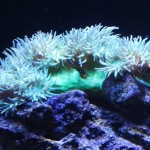
Duncan Corals
Scientific Name: Duncanopsammia Axifuga
Common Name: Duncan Coral, Whisker Coral, Daisy Coral,
Type of Coral: LPS (Large Polyp Stony Coral)
Lighting: Moderate
Flow: Moderate
Care Level: Moderate
Temperament: Peaceful to Semi-Aggressive
Appearance
Duncan corals will have a base that consists of an calcified skeleton structure covered in a green or pink colored thin layer of flesh. At the end of this structure will be individual fleshy heads with long polyps extending around the edges and a mouth in the center of the head. The heads will be a similar color to the base.

Water Conditions
The below link highlights typical water conditions Duncan corals, as with most LPS, will require. As this is a moderately difficult coral to keep, you should ensure your dKH, Cal and Mag levels are maintained at all times with minimal nitrate and phosphate levels. As this coral also has a calcified skeleton, it will consume calcium from your water. In set-ups with a good amount of LPS corals, it is not uncommon to have to dose dKH and Cal in order to keep the water parameters in line. With only a few LPS corals, a good water change schedule may be enough to maintain your parameters. In addition to the article in the below link, this coral can also benefit from maintaining strontium levels if you do not have a good water change routine using a very good quality salt.
https://www.reefaquarium.com/2013/the-basics-of-marine-aquarium-water-parameters/
General Information
Duncan corals, as with all other LPS corals, should be added to mature aquariums. Provided all their requirements are met, they can grow to a very large colony within a few short years. Unless you are planning to move or frag your duncan coral, you should give it as much as 20 inches of space in your tank.
The Duncan coral will release sweeper / feeder tentacles from its heads to collect food. This will mostly happen when the tanks lights are off. These tentacles can also sting and damage or kill other corals within reach, which is how the duncan coral will defend itself. What makes the duncan coral more peaceful than most LPS coral is that its sweeper tentacles are much shorter in comparison only measuring a few inches in length.
Although the duncan coral will get what it needs from the lighting in your tank, it can also benefit from micro plankton or manual feeding of small pcs of meaty foods placed directly on the mouths at the center of each head. Although manual feedings are not required, it will help to accelerate growth.
As with all corals, the exterior slime coating can be a skin irritant or even highly toxic to humans so please, handle all corals with care. I would recommend wearing rubber gloves whenever you handle corals
Fragging
Duncan corals can be fragged with very good success.

Ricordea Mushroom Corals
Scientific Name: Ricordea Florida
Common Name: Ricordea Mushroom, Anemone Mushroom
Type of Coral: Softie
Lighting: Moderate and Moderate to Low
Flow: Moderate
Care Level: Easy
Temperament: Semi-aggressive
Appearance
Ricordeas can also be found in a wide verity of colors and sizes making then a very great choice to add some color to any reef aquarium. It is also common to find some that have three different colors on them, one color around the edge of the cap, one color on the cap itself, and a third color in the center of the ricordeas. The surface of their cap looks like it is made up of small little balls giving them a very interesting structure. They also commonly range in size from ½ inch to 3 inches, but there are a few types of Ricordeas that do get larger. The below pictures are just a few examples.

Water Conditions
The below link highlights typical water conditions Ricordeas will require. I have had the best luck with ricordeas when kept in water with 1 to 2 ppm of nitrate when lighting and flow requirements were meat and all other water parameters in line as described in the below link.
https://www.reefaquarium.com/2013/the-basics-of-marine-aquarium-water-parameters/
General Information
As Ricordeas do not have a calcified skeleton structure, they can be more tolerant of swings in the alkalinity, calcium, and magnesium when compared to other corals. However, they will not be very tolerance to swings in pH, Temp, or salinity which is no different than any other coral or fish. They are a very hardly coral making them a good choice for people new to the hobby. As with most other corals, Ricordeas have natural defense mechanisms to protect themselves. They have a chemical defense system based on stinging tentacle that will extend out from its cap. This can be harmfully to certain types of other soft corals and SPS corals. This makes it important to ensure you leave about 2 inches of space between your mushroom corals and other types of corals you may have in your tank. Ricordeas will do best when placed on your live rock in your tank.
As with all corals, the exterior slime coating can be a skin irritant or even highly toxic to humans so please, handle all corals with care. I would recommend wearing rubber glove whenever you handle corals
Fragging
Ricordeas can be easily fragged with very high success

Long Polyp Leather Coral
Scientific Name: Sarcophyton SP
Common Name: Long Polyp Leather, Long Polyp Toadstool Leather
Type of Coral: Softie
Lighting: Moderate and Moderate to Low
Flow: Moderate and moderate to high
Care Level: Easy
Temperament: Semi-aggressive
Appearance
Generally speaking, leather corals are a soft skinned coral with visible polyps all over their skin. A leather coral can look one way in a aquarium and then (over time) look very different when placed in another tank based only on the water parameters, lighting and flow.
There will typically be a short light brown colored base with a head structure on top that will make it look a lot like a mushroom. It will have longer polyps on the head that are a little lighter color than the base and that can range in length of up to a inch. The polyps can be gold to light brown in color. The head of this coral can get as big as 5 inches so you should leave at least 8 to 9 inches of space all around this coral to help prevent any defensive response from this coral
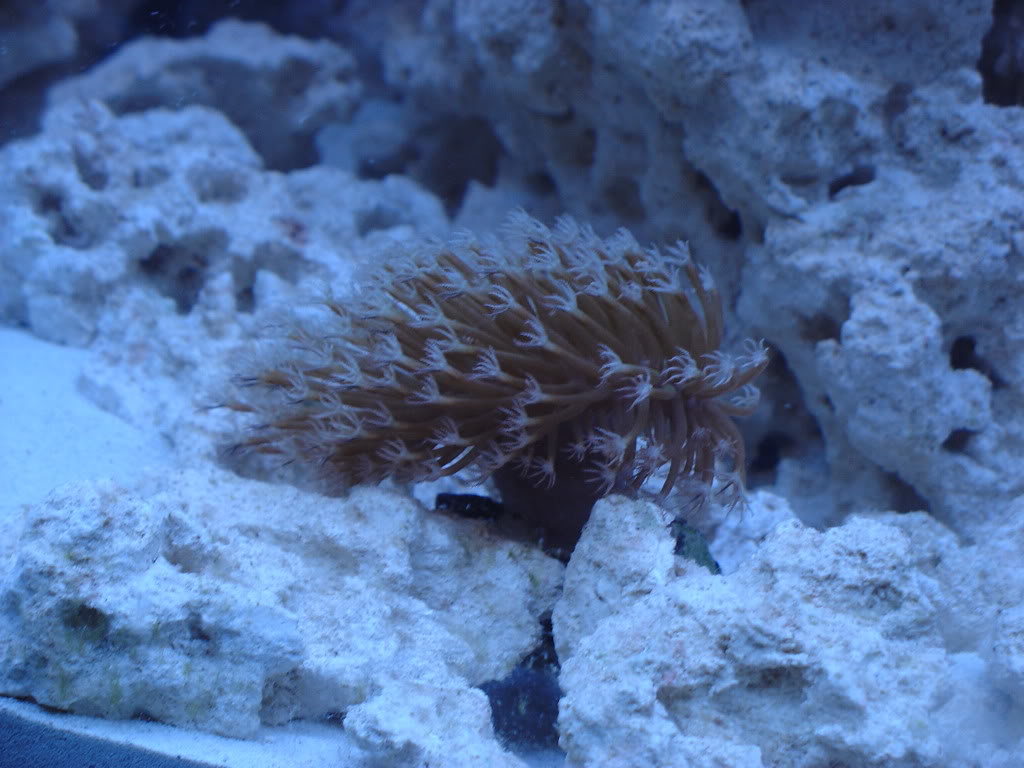
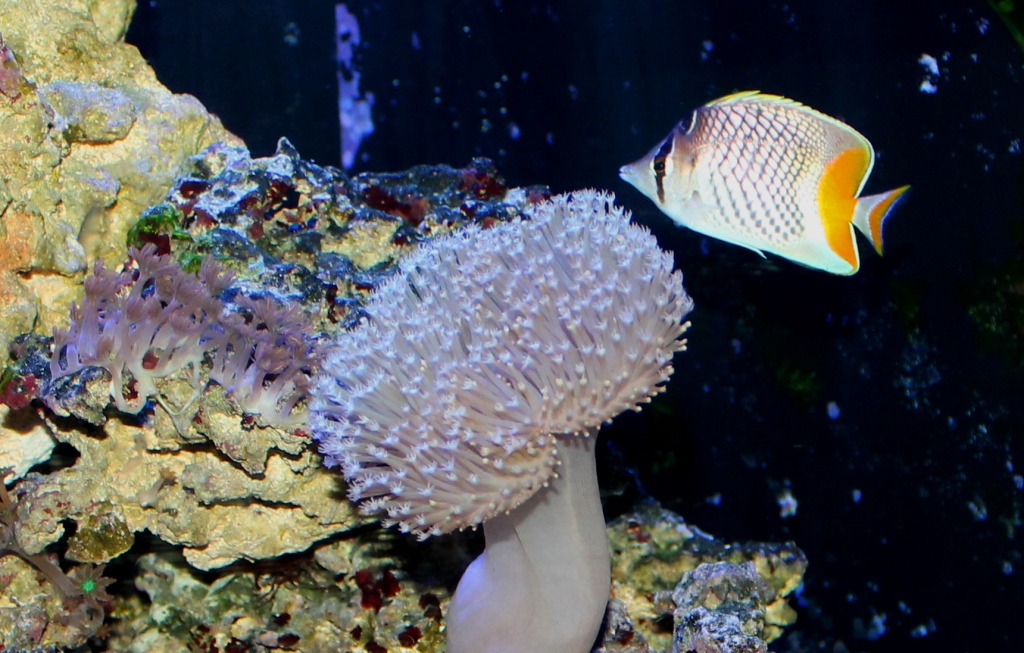
Water Conditions
The below link highlights typical water conditions this leather coral will require. I have had the best luck when they were kept in water with 1 to 2 ppm of nitrate when lighting and flow requirements were met and all other water parameters in line as described in the below link.
https://www.reefaquarium.com/2013/the-basics-of-marine-aquarium-water-parameters/
General Information
They do not have a calcified skeleton structure making them a little more tolerant of some water parameters like calcium. However, they will not be very tolerance to swings in pH, Temp, or salinity which is no different than any other coral or fish. They are a very hardly coral making them a good choice for people new to the hobby. Most leathers have a very effective defensive ability. Leathers commonly have the ability to sting other corals and some fish along with emitting chemicals to ward off other corals from entering their space. For this reason it is very important to understand how big your leather coral can get and plan for enough space between your leather coral and other corals. Just leaving a few inches may not always be enough as some leathers can get surprisingly large. It would also be a good idea to have some carbon in your set-up in case your leather will start to emit defensive chemicals. This is one coral that will be the least likely to be picked on by most fish in the hobby.
As with all corals, the exterior slime coating can be a skin irritant or even highly toxic to humans so please, handle all corals with care. I would recommend wearing rubber glove whenever you handle corals
Fragging
Leathers can be easily fragged with very high success
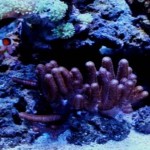
Finger Leather
Scientific Name: Sinularia SP
Common Name: Finger Leather.
Type of Coral: Softie
Lighting: Moderate and Moderate to Low
Flow: Moderate and moderate to high
Care Level: Easy
Temperament: Semi-aggressive
Appearance
Generally speaking, leather corals are a soft skinned coral with visible polyps all over their skin. A leather coral can look one way in a aquarium and then (over time) look very different when placed in another tank based only on the water parameters, lighting and flow.
The polyps will have a little different color than the base. These leathers can get up to 8 inches in height and around 12 inch wide along the base. This coral will need anywhere from 14 to 15 inches of space in a aquarium. Due to their size and coloring, many hobbyists have used them as a center pc coral. They can come in a variety of different colors.

Water Conditions
The below link highlights typical water conditions this leather coral will require. I have had the best luck when they were kept in water with 1 to 2 ppm of nitrate when lighting and flow requirements were met and all other water parameters in line as described in the below link.
https://www.reefaquarium.com/2013/the-basics-of-marine-aquarium-water-parameters/
General Information
They do not have a calcified skeleton structure making them a little more tolerant of some water parameters like calcium. However, they will not be very tolerance to swings in pH, Temp, or salinity which is no different than any other coral or fish. They are a very hardly coral making them a good choice for people new to the hobby. Most leathers have some very effective defensive abilities. Leathers commonly have the ability to sting other corals and some fish along with emitting chemicals to ward off other corals from entering their space. For this reason it is very important to understand how big your leather coral can get and plan for enough space between your leather coral and other corals. Just leaving a few inches may not always be enough as some leathers can get surprisingly large. It would also be a good idea to have some carbon in your set-up in case your leather will start to emit defensive chemicals. This is one coral that will be the least likely to be picked on by most fish in the hobby.
As with all corals, the exterior slime coating can be a skin irritant or even highly toxic to humans so please, handle all corals with care. I would recommend wearing rubber glove whenever you handle corals
Fragging
This leathers can be easily fragged with very high success
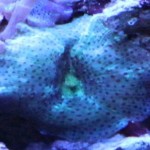
Mushroom Corals
Scientific Name: Actinodiscus SP
Common Name: Mushroom Corals
Type of Coral: Softie
Lighting: Moderate and Moderate to Low
Flow: Moderate
Care Level: Easy
Temperament: Semi-aggressive
Appearance
Mushrooms can also be found in a wide verity of colors and sizes making then a very great choice to add some color to any reef aquarium. They also commonly range in size from ½ inch to 2 inches, but there are a few types of mushrooms that do get larger. The below pictures are just a few examples.
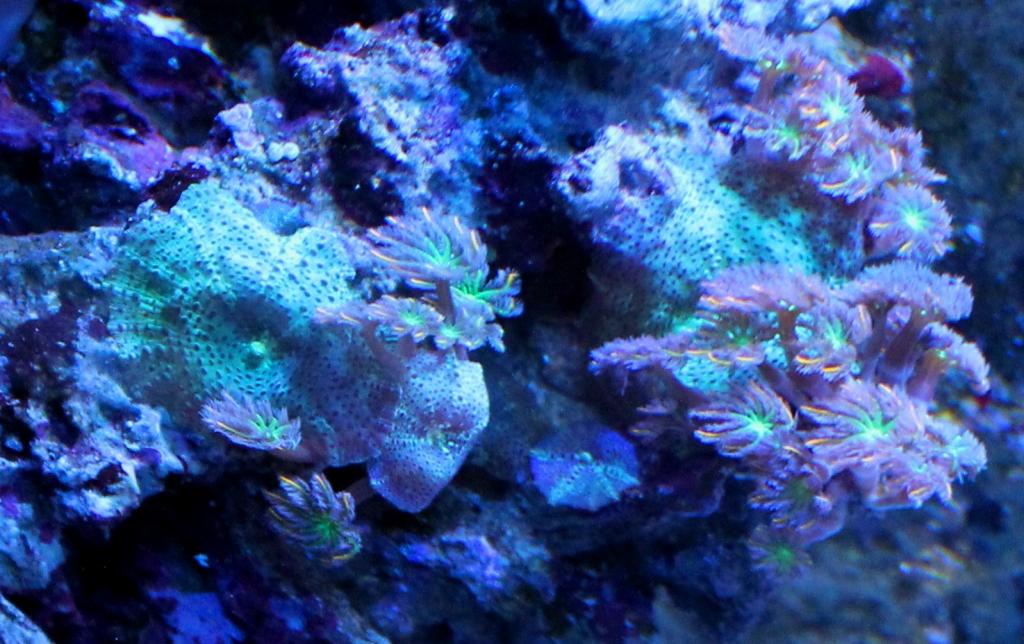

Water Conditions
The below link highlights typical water conditions mushrooms will require. I have had the best luck with mushrooms when kept in water with 1 to 2 ppm of nitrate when lighting and flow requirements were met and all other water parameters in line as described in the below link.
https://www.reefaquarium.com/2013/the-basics-of-marine-aquarium-water-parameters/
General Information
As mushroom do not have a calcified skeleton structure, they can be more tolerant of swings in the alkalinity, calcium, and magnesium when compared to other corals. However, they will not be very tolerance to swings in pH, Temp, or salinity which is no different than any other coral or fish. They are a very hardly coral making them a good choice for people new to the hobby. As with most other corals, mushrooms have natural defense mechanisms to protect themselves. They have a chemical defense system based on stinging tentacle that will extend out from its cap. This can be harmfully to certain types of other soft corals and SPS corals. This makes it important to ensure you leave about 2 inches of space between your mushroom corals and other types of corals you may have in your tank. Mushroom will do best when placed on your live rock in your tank.
As with all corals, the exterior slime coating can be a skin irritant or even highly toxic to humans so please, handle all corals with care. I would recommend wearing rubber glove whenever you handle corals
Fragging
Mushrooms can be easily fragged with very high success

Green Nepthea Leather
Scientific Name: Nepthea SP
Common Name: Green Palua Neptha, Green Neptha Leather
Type of Coral: Softie
Lighting: Moderate and Moderate to Low
Flow: Moderate and moderate to high
Care Level: Easy
Temperament: Semi-aggressive
Appearance
Generally speaking, leather corals are a soft skinned coral with visible polyps all over their skin. A leather coral can look one way in a aquarium and then (over time) look very different when placed in another tank based only on the water parameters, lighting and flow.
The green nepthea will look like a little tree with fat branches and are green in color. The coloring can range from bright almost neon green to a darker green. The branches of the green nepthea leather coral will be covered in short polyps a little lighter in color than the base which, at times, can make it look almost “furry”. This coral should ideally get around 10 inches of tank space for its long term growth.


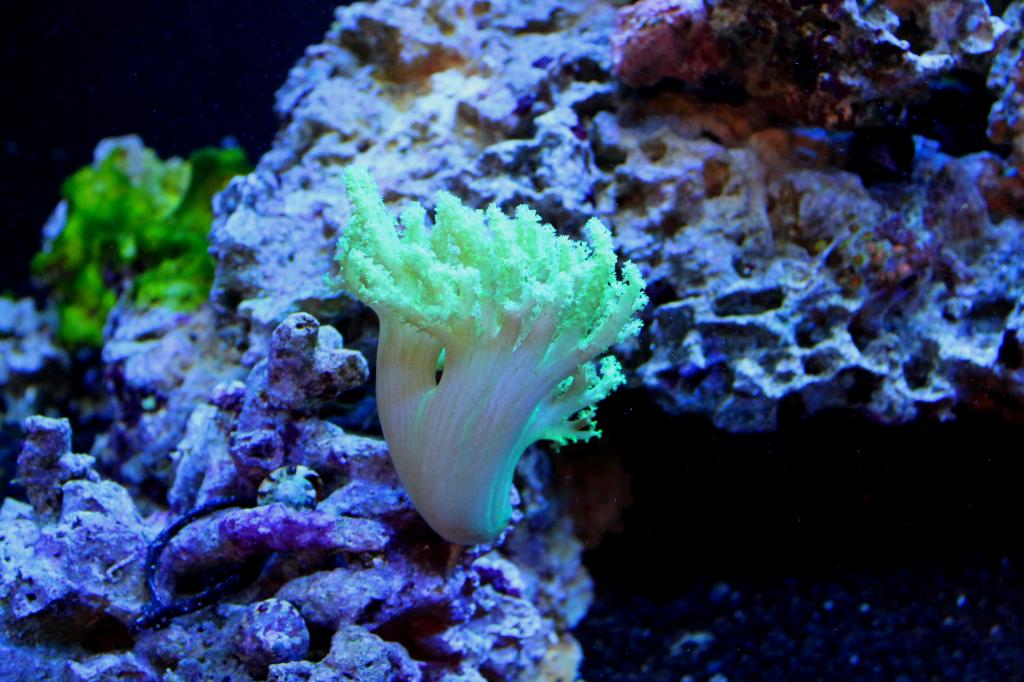
Water Conditions
The below link highlights typical water conditions a green nepthea leather coral will require. I have had the best luck when they were kept in water with 1 to 2 ppm of nitrate when lighting and flow requirements were met and all other water parameters in line as described in the below link.
https://www.reefaquarium.com/2013/the-basics-of-marine-aquarium-water-parameters/
General Information
They do not have a calcified skeleton structure making them a little more tolerant of some water parameters like calcium. However, they will not be very tolerance to swings in pH, Temp, or salinity which is no different than any other coral or fish. They are a very hardly coral making them a good choice for people new to the hobby. Most leathers have some very effective defensive abilities. Leathers commonly have the ability to sting other corals and some fish along with emitting chemicals to ward off other corals from entering their space. For this reason it is very important to understand how big your leather coral can get and plan for enough space between your leather coral and other corals. Just leaving a few inches may not always be enough as some leathers can get surprisingly large. It would also be a good idea to have some carbon in your set-up in case your leather will start to emit defensive chemicals. This is one coral that will be the least likely to be picked on by most fish in the hobby.
As with all corals, the exterior slime coating can be a skin irritant or even highly toxic to humans so please, handle all corals with care. I would recommend wearing rubber glove whenever you handle corals
Fragging
This Leather can be easily fragged with very high success

Button Polyps, or, Palys
Scientific Name: Protopalythoa sp.
Common Name: Palythoas, Palys, Button Polyps
Type of Coral: Softie
Lighting: Moderate and Moderate to Low
Flow: Moderate and Moderate to Low
Care Level: Easy
Temperament: Peaceful to Semi-aggressive
Appearance
These corals can come in a wide range colors and color combinations. While the heads can range in size from ½ to 2 inches, and the colony can grow at a fairly fast pace. The edges of the heads can have a different texture when compared with zoas, however, for the most part palys are very similar in appearance to zoas.

Water Conditions
The below link highlights typical water conditions palys will require. I have had the best luck when they were kept in water with 1 to 2 ppm of nitrate when lighting and flow requirements were meat and all other water parameters in line as described in the below link.
https://www.reefaquarium.com/2013/the-basics-of-marine-aquarium-water-parameters/
General Information
Palys are a colonial coral, meaning they form a colony of many individual polyps all connected together. As they do not have a calcified skeleton structure, they can be more tolerant of swings in the alkalinity, calcium, and magnesium when compared to other corals. However, they will not be very tolerant to swings in pH, Temp, or salinity which is no different than any other coral or fish.. This makes palys are a very hardy soft coral placing them amount the easier to keep corals and making them an excellent choice as corals for beginners. They have also been known to grow very fast, almost like an invasive coral. Palys are also the least aggressive when it comes to defensive abilities. They can quite frequently become damaged and even start losing heads when they fall victim to another coral’s sting or exposed to those toxins. In addition, the protective slime like coating that is on the palys can sometimes be a delicacy among the “coral nipping” fish. This corals typically dies when a fish removes the outer slim coating from the coral.
The exterior slime coating on some types of palys is among the most toxic to humans as compared to other common corals in the hobby. For this reason, please handle palys with care. I would recommend wearing rubber glove whenever you handle corals
Fragging
Palys can be easily fragged with very high success

Torch Corals
Scientific Name: Euphyilla Glabrescens
Common Name: Torch Coral, Pom-pom coral
Type of Coral: LPS (Large Polyp Stony Coral)
Lighting: Moderate and Moderate to High
Flow: Moderate
Care Level: Moderate
Temperament: Semi-aggressive to Aggressive
Appearance
Torch corals will have a base that consists of an exposed calcified skeleton structure. At the end of this structure will be individual fleshy heads with long flowing polyps with lighter coloring at the tips. The heads can be a within a range of colors ranging from pink, green, gold, and brown. As this coral grows, the heads will split and the skeleton base will branch almost like a tree grows. These corals can sometimes be mistaken for a Hammer coral or a Frogspawn Coral. The appearance of the polyps on the heads will allow you to properly identify a torch coral.
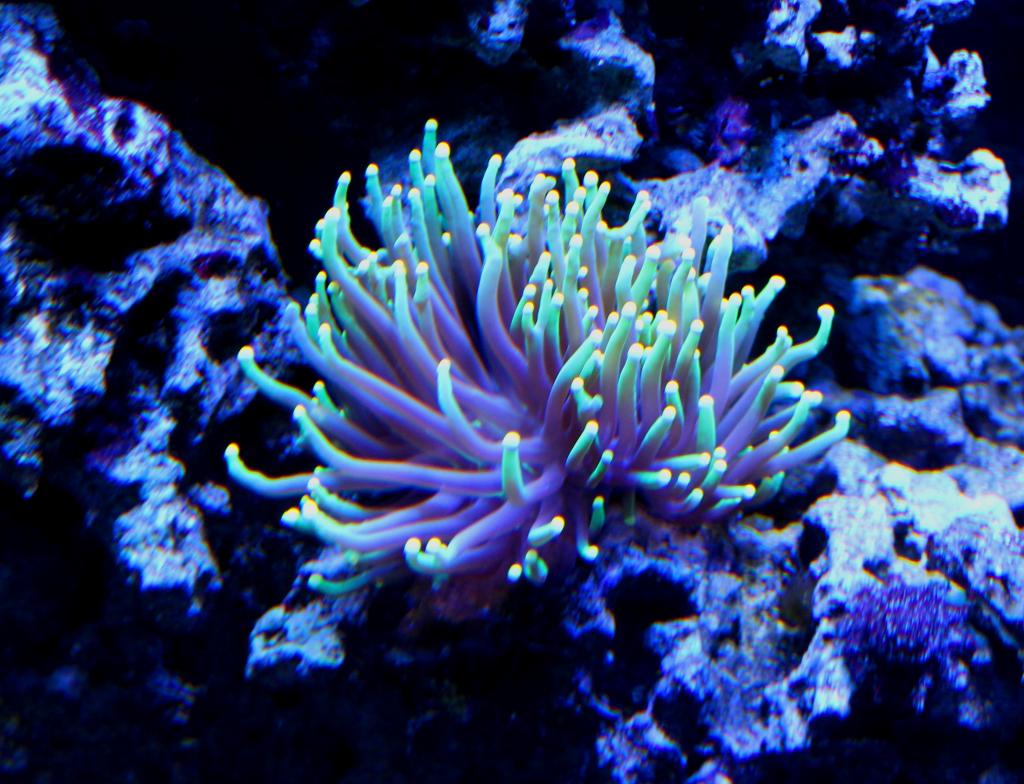
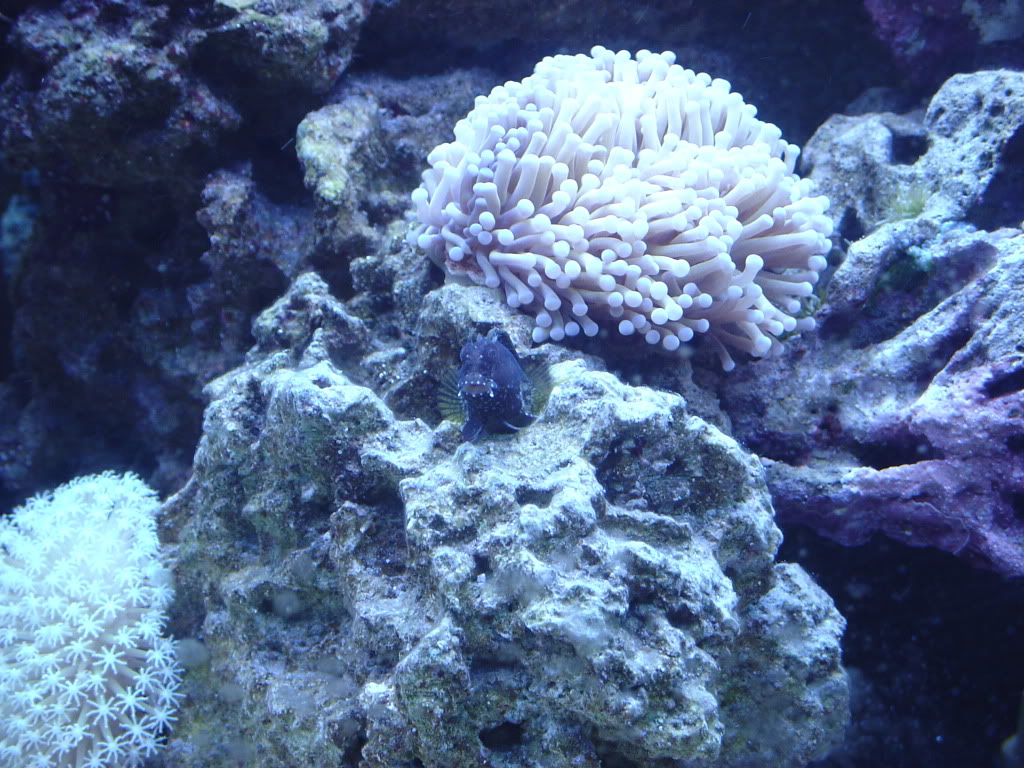
Water Conditions
The below link highlights typical water conditions torch corals, as with most LPS, will require. As this is a moderately difficult coral to keep, you should ensure your dKH, Cal and Mag levels are maintained at all times with minimal nitrate and phosphate levels. As this coral also has a calcified skeleton, it will consume calcium from your water. In set-ups with a good amount of LPS corals, it is not uncommon to have to dose dKH and Cal in order to keep the water parameters in line. With only a few LPS corals, a good water change schedule may be enough to maintain your parameters. In addition to the article in the below link, this coral can also benefit from maintaining strontium levels if you do not have a good water change routine using a very good quality salt.
https://www.reefaquarium.com/2013/the-basics-of-marine-aquarium-water-parameters/
General Information
Torch corals, as with all other LPS corals, should be added to mature aquariums. Provided all their requirements are met, they can grow to a colony about the size of your average basket ball within a few short years. Unless you are planning to move or frag your torch coral, you should give it as much as 30 inches of space in your tank.
The torch coral will release long sweeper / feeder tentacles from its heads to collect food. This will mostly happen when the tanks lights are off. These tentacles can also sting and damage or kill other corals within reach, which is how the torch coral will defend itself. This is what makes the torch more of an aggressive coral as the tentacles can extend as much as 6 to 7 inches beyond the heads.
Although the torch coral will get what it needs from the lighting in your tank, it can also benefit from micro plankton or manual feeding of small pcs of meaty foods placed directly on the mouths at the center of each head. Although manual feedings are not required, it will help to accelerate growth.
Clownfish have also been known to host in torch corals in aquariums that do not have anemones. Although this will not harm the clownfish, this can sometimes stress the coral to the point where some of its heads could die off.
As with all corals, the exterior slime coating can be a skin irritant or even highly toxic to humans so please, handle all corals with care. I would recommend wearing rubber gloves whenever you handle corals
Fragging
Torch corals can be fragged with very good success.
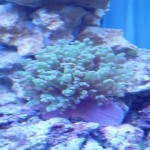
Frogspawn Coral
Scientific Name: Euphyilla Paradivisa
Common Name: Frogspawn Coral
Type of Coral: LPS (Large Polyp Stony Coral)
Lighting: Moderate and Moderate to High
Flow: Moderate and Moderate to High
Care Level: Moderate
Temperament: Semi-aggressive to Aggressive
Appearance
Frogspawn corals will have a base that consists of an exposed calcified skeleton structure. At the end of this structure will be individual fleshy heads with polyps on it. The tips of the polyps will typically be a lighter color when compared to the rest of the polyp. The heads can be a within a range of colors ranging from green, pink, gold, and brown. As this coral grows, the heads will split and the skeleton base will branch almost like a tree grows. The polyps on the heads of this coral will look almost like a mass of frog eggs which is where its common name originated from. These corals can sometimes be mistaken for a Torch coral or a Hammer Coral. The appearance of the polyps on the heads will allow you to properly identify a frogspawn coral.

Water Conditions
The below link highlights typical water conditions frogspawn corals, as with most LPS, will require. As this is a moderately difficult coral to keep, you should ensure your dKH, Cal and Mag levels are maintained at all times with minimal nitrate and phosphate levels. As this coral also has a calcified skeleton, it will consume calcium from your water. In set-ups with a good amount of LPS corals, it is not uncommon to have to dose dKH and Cal in order to keep the water parameters in line. With only a few LPS corals, a good water change schedule may be enough to maintain your parameters. In addition to the article in the below link, this coral can also benefit from maintaining strontium levels if you do not have a good water change routine using a very good quality salt.
https://www.reefaquarium.com/2013/the-basics-of-marine-aquarium-water-parameters/
General Information
Frogspawn corals, as with all other LPS corals, should be added to mature aquariums. Provided all their requirements are met, that can grow to a colony about the size of your average basket ball within a few short years. Unless you are planning to move or frag your frogspawn coral, you should give it as much as 30 inches of space in your tank.
The frogspawn coral will release long sweeper / feeder tentacles from its heads to collect food. This will mostly happen when the tanks lights are off. These tentacles can also sting and damage or kill other corals within reach, which is how the frogspawn coral will defend itself. This is what makes the frogspawn more of an aggressive coral as the tentacles can extend as much as 6 to 7 inches beyond the heads.
Although the frogspawn coral will get what it needs from the lighting in your tank, it can also benefit from micro plankton or manual feeding of small pcs of meaty foods placed directly on the mouths at the center of each head. Although manual feedings are not required, it will help to accelerate growth.
As with all corals, the exterior slime coating can be a skin irritant or even highly toxic to humans so please, handle all corals with care. I would recommend wearing rubber gloves whenever you handle corals
Clownfish have also been known to host in frogspawn corals in aquariums that do not have anemones. Although this will not harm the clownfish, this can sometimes stress the coral to the point where some of its heads could die off.
Fragging
Frogspawn corals can be fragged with very good success.